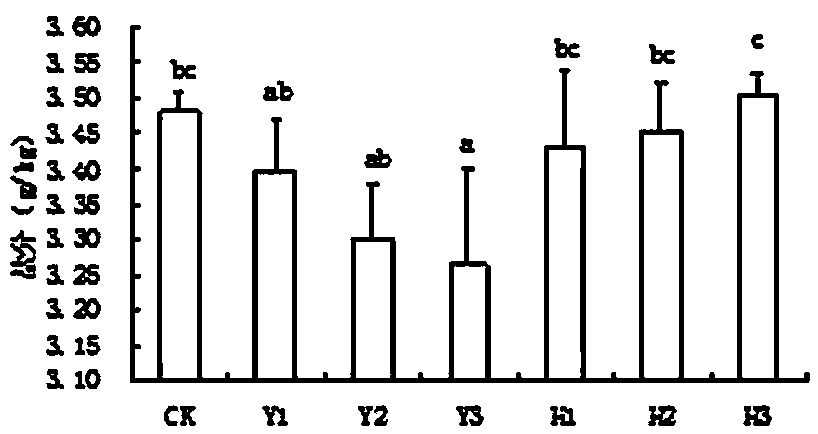Dry farming cultivation method for amaranthus hypochondriacus in moderate-severe saline-alkali soil
A technology of severe saline-alkali soil and cultivation method, which is applied in the field of Qiansui Valley dry-farming cultivation in medium-to-severe saline-alkali land, can solve the problems of low survival rate, poor biological yield, and low plant emergence rate, so as to improve the emergence rate, avoid crazy growth and lodging, and ensure The effect of high-yield cultivation
- Summary
- Abstract
- Description
- Claims
- Application Information
AI Technical Summary
Problems solved by technology
Method used
Image
Examples
Embodiment 1
[0030] Taking the saline-alkali land experiment field in Haixing County, Cangzhou City as an example, the dry-farming cultivation method of Qiansui Valley in medium-to-severe saline-alkali land is introduced in detail.
[0031] The pH value of the soil in the saline-alkali test field in Haixing County, Cangzhou City is 8.1, and the salinity degree is 0.34%. The soil composition analysis of the test site is shown in Table 1.
[0032] Table 1
[0033]
[0034] (1) Soil treatment before sowing
[0035] Land preparation: Before the summer rainy season, level the land and organize the land into fields with ridges on all sides. One side of the ridges is provided with a 0.5m long gap, and the area of the fields is 15m 2 , the field slope is 3°.
[0036] Salt spraying: use the first moderate rain in June (about 40 m 3 Fresh water) spray salt, and after the rainfall ends, the remaining water in the field will be introduced into the drainage ditch;
[0037] Fertilization: On th...
Embodiment 2
[0046] Different fertilizers were used as basal fertilizers to detect the effects on the growth of Qiansui Gu. The fertilizers used are shown in Table 1. At the same time, blank fertilizers were used as controls. A total of 7 treatments were used, and each treatment was repeated 3 times. Field area is 10m 2 (2m×5m), the sowing rate of Qiansui Valley is 12kg / hm 2 , every block is planted 5 rows, and row spacing is 40cm; Other operations are identical with embodiment 1. See Table 2 for details.
[0047] The fertilizer adopted in the table 2 embodiment 2
[0048] Unit: (kg / hm 2 )
[0049]
[0050]Among them, the total nutrients of the applied organic fertilizer are more than 4% (of which total N is 1.38%, total P is 1.62%, and total K is 1.31%), and the organic matter is 32%. Calculate the amount of organic fertilizer based on the total potassium content of the organic fertilizer. If the nitrogen and phosphorus nutrients are insufficient, use chemical fertilizers to suppl...
Embodiment 3~5
[0057] Soils with different salinity were configured, and Chisui Valley was planted with different fertilization rates. Other experimental methods were the same as in Example 1. After 1 year of planting, the Qiansui Valley was cut for 3 times. Compared with the traditional planting method (comparative example), the experimental results are shown in Table 3. Compared with the traditional method, the method of the invention can remarkably improve the emergence rate, survival rate and yield of Qiansui Gu, is suitable for popularization in medium-severe saline-alkali land, and has the effect of improving soil.
[0058] The traditional cultivation method is as follows: apply nitrogen fertilizer, and the amount of application is enough to make the amount of pure nitrogen 15kg / mu (225 kg / hm 2 ); the seeding rate was 0.7 kg / mu; the row spacing was 50 cm; the seeding depth was 1.0 cm.
[0059] table 3
[0060]
PUM
 Login to View More
Login to View More Abstract
Description
Claims
Application Information
 Login to View More
Login to View More - R&D
- Intellectual Property
- Life Sciences
- Materials
- Tech Scout
- Unparalleled Data Quality
- Higher Quality Content
- 60% Fewer Hallucinations
Browse by: Latest US Patents, China's latest patents, Technical Efficacy Thesaurus, Application Domain, Technology Topic, Popular Technical Reports.
© 2025 PatSnap. All rights reserved.Legal|Privacy policy|Modern Slavery Act Transparency Statement|Sitemap|About US| Contact US: help@patsnap.com



